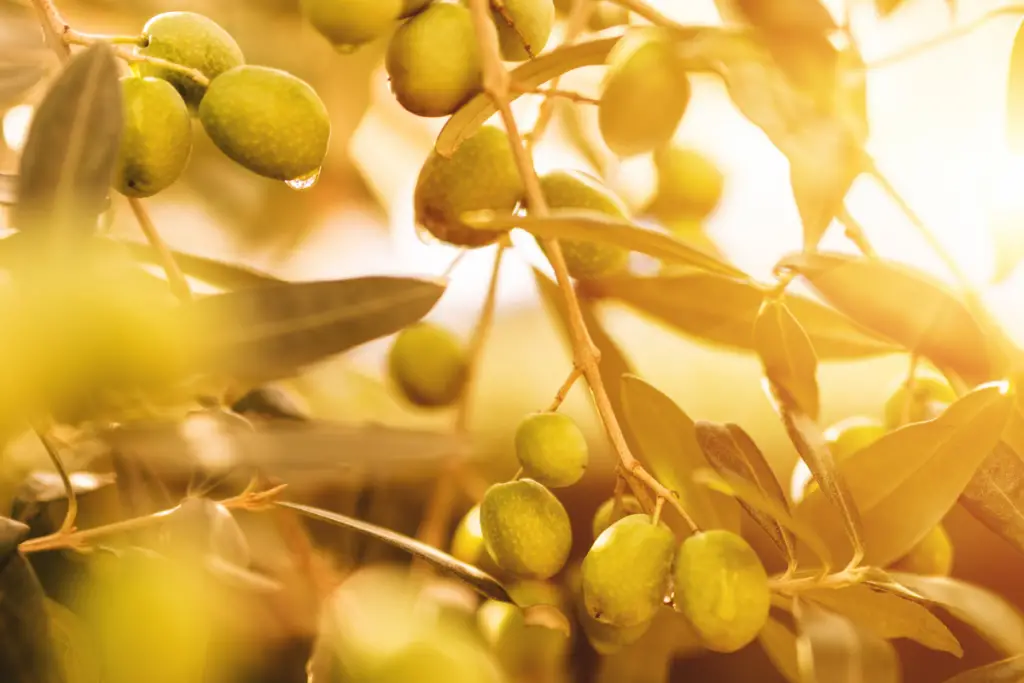Growing and caring for olive trees is a great way to add a Mediterranean touch to your garden or home.
Olive trees are relatively easy to grow and maintain, making them a popular choice for gardeners and homeowners alike.
The trees are also known for their longevity, with some living for hundreds of years.
When it comes to growing olive trees, the first step is to choose the right location. Olive trees thrive in warm, sunny climates and well-drained soil.
They can also be grown in containers and moved indoors during colder months.
Proper watering and fertilization are also essential for healthy growth, and pruning can help control the tree’s size and shape. With the right care, olive trees can produce fruit for many years.

Table of Contents
Understanding Olive Trees
Olive trees (Olea europaea) are evergreen trees that are native to the Mediterranean region. They can grow up to 50 feet tall and have a spread of up to 30 feet.
Olive trees are known for their attractive, silver-green leaves and their ability to produce fruit, which is commonly used to make olive oil.
When it comes to growing olive trees, it’s important to understand their basic needs. Olive trees require full sun and well-draining soil.
They are drought-tolerant, but they do require regular watering during the growing season. It’s also important to note that olive trees are not frost-tolerant, so they should only be grown in areas with mild winters.
Olive trees are also sensitive to soil pH. They prefer soil with a pH between 5.5 and 7.5.
If the soil is too acidic or alkaline, the tree may not produce fruit or may produce fruit that is of poor quality.
When it comes to pruning olive trees, it’s important to do so in the late winter or early spring before the tree begins to produce new growth.
Pruning should focus on removing any dead or diseased wood, as well as any branches that are crossing or rubbing against each other.
Pruning can also help to shape the tree and improve its overall health.
Choosing the Right Olive Tree
When it comes to choosing the right olive tree, there are several factors to consider.
In this section, we will discuss the different olive tree varieties and climate considerations to help you make an informed decision.
Olive Tree Varieties
There are countless olive tree varieties to choose from, but not all are suitable for every climate.
Some popular varieties include:
- Arbequina: A small, hardy tree that produces small, flavorful olives. Suitable for warm climates.
- Koroneiki: A high-yielding tree that produces small olives with a high oil content. Suitable for warm climates.
- Mission: A large, slow-growing tree that produces large, meaty olives. Suitable for cool to warm climates.
- Picual: A high-yielding tree that produces medium-sized olives with a high oil content. Suitable for warm climates.
- Manzanillo: A large, fast-growing tree that produces large, meaty olives. Suitable for warm climates.
It’s important to choose a variety that is well-suited for your climate to ensure the tree will thrive.
Climate Considerations
Olive trees are native to the Mediterranean region and prefer warm, dry climates. They can tolerate some cold temperatures, but prolonged freezing temperatures can damage or kill the tree.
When choosing an olive tree, consider the following climate factors:
- Temperature: Olive trees prefer temperatures between 60-85°F (15-29°C). They can tolerate temperatures as low as 20°F (-6°C) for short periods of time, but prolonged freezing temperatures can damage or kill the tree.
- Sunlight: Olive trees require full sun to thrive. Choose a location that receives at least 6 hours of direct sunlight per day.
- Soil: Olive trees prefer well-draining soil with a pH between 5.5-7.5. Avoid planting in heavy clay soils or areas with poor drainage.
By considering these factors, you can choose an olive tree variety that is well-suited for your climate and ensure the tree will thrive.
Planting Olive Trees
Choosing the Right Location
When planting olive trees, it is important to choose the right location. Olive trees require plenty of sunlight and well-drained soil.
They do not grow well in areas with high humidity or where the soil is constantly wet. It is also important to choose a location that is protected from strong winds that can damage the trees.
Soil Preparation
Before planting olive trees, it is important to prepare the soil. Olive trees prefer soil with a pH level between 5.5 and 7.5.
The soil should be well-drained and rich in organic matter. If the soil is too acidic, it can be amended with lime. If the soil is too alkaline, it can be amended with sulfur.
Prices pulled from the Amazon Product Advertising API on:
Product prices and availability are accurate as of the date/time indicated and are subject to change. Any price and availability information displayed on [relevant Amazon Site(s), as applicable] at the time of purchase will apply to the purchase of this product.
Planting Procedure
When planting olive trees, it is important to dig a hole that is twice as wide and deep as the root ball. The hole should be filled with a mixture of soil and organic matter.
The tree should be planted at the same depth it was in its container. After planting, the tree should be watered thoroughly.
It is important to mulch around the base of the tree to help retain moisture and suppress weeds. The mulch should be kept a few inches away from the trunk of the tree to prevent rot.
Olive trees should be watered regularly, especially during the first few years after planting. However, it is important not to overwater the trees as this can lead to root rot.
Fertilizer can be applied in the spring and fall to help promote growth and fruit production.
Caring for Olive Trees
Growing olive trees is relatively simple given the proper location, but caring for them is essential to ensure a healthy and productive tree.
Olive trees require specific watering, pruning, and fertilizing to thrive.
Watering Requirements
Olive trees require moderate watering, especially during the growing season. The soil should be kept moist but not waterlogged.
Overwatering can lead to root rot, while underwatering can cause the tree to wilt.
A good rule of thumb is to water the tree every 7-10 days, depending on the weather conditions.
Newly planted trees require more frequent watering until they establish their roots.
Pruning Techniques
Pruning is an essential aspect of olive tree care. Pruning helps to shape the tree, promote healthy growth, and improve fruit production.
Pruning should be done during the dormant season, typically in late winter or early spring.
Dead, damaged, or diseased branches should be removed, as well as any suckers that grow from the base of the tree.
It is also important to thin out the canopy of the tree to allow sunlight to penetrate the inner branches. This will help to promote healthy growth and improve fruit production.
Fertilizing Needs
Olive trees require regular fertilization to ensure healthy growth and fruit production. Fertilizer should be applied in early spring before new growth begins.
A balanced fertilizer with equal amounts of nitrogen, phosphorus, and potassium is recommended. Alternatively, a fertilizer specifically formulated for olive trees can be used.
It is important not to over-fertilize, as this can lead to excessive vegetative growth at the expense of fruit production.
A good rule of thumb is to fertilize the tree every 6-8 weeks during the growing season.
Pest and Disease Management
Olive trees are relatively low-maintenance, but they are still susceptible to a few pests and diseases.
Here are some common issues and how to manage them:
Pests
- Scale: Scale insects are usually found on the bark of young twigs and branches. They are encrusted with small, hard, circular, scaly raised bumps with yellow centers. They may also be on the fruit. Sap feeding weakens the tree. To control scale, consult a County Extension Agent.
- Mites: Mites are pinpoint size and come in many different colors. They are found on the undersides of leaves. Sap feeding causes bronzing of leaves. To control mites, spray the tree with a miticide.
Diseases
- Olive knot: Olive knot is a bacterial disease that causes galls to form on the branches and trunk of the tree. To control olive knot, prune out infected wood and dispose of it properly. Disinfect pruning tools between cuts with a solution of 1 part bleach to 9 parts water.
- Olive anthracnose: Olive anthracnose is a fungal disease that causes dark, sunken lesions on the fruit. To control olive anthracnose, spray the tree with a fungicide. Make sure to follow the instructions on the label carefully.
It’s important to note that prevention is the key to maintaining healthy olive trees.
Regularly inspect the tree for signs of pests and diseases, and take action as soon as you notice any issues.
Keeping the tree healthy by providing proper irrigation and fertilization can also help prevent problems.
Harvesting and Storing Olives
Once the olive trees have matured and started producing fruit, it’s time to harvest them. The timing of the harvest depends on the type of olive and the desired end product.
For table olives, the olives are typically harvested when they are fully ripe, while for olive oil production, the olives are often harvested when they are still green and unripe.
The harvesting process can be done by hand or with the use of machines.
Hand harvesting involves picking the olives off the tree by hand, while mechanical harvesting involves using a shaker to shake the tree, causing the olives to fall onto a net or tarp below.
After harvesting, the olives should be sorted and cleaned to remove any leaves, stems, or other debris.
The olives can then be stored in a cool, dry place for a few days to allow them to fully ripen and develop their flavor.
When it comes to storing olives, there are a few options. For short-term storage, olives can be stored in the refrigerator in a brine solution made of salt and water.
For long-term storage, olives can be preserved in jars or cans with a brine solution or olive oil.
It’s important to note that olives can be quite bitter when they are first harvested, and they require processing to remove this bitterness.
This can be done through methods such as soaking the olives in water or brine, or by using chemicals such as lye.
It’s important to follow proper processing methods to ensure the olives are safe to eat.
Winter Care for Olive Trees
Olive trees are hardy plants that can tolerate a wide range of temperatures, but they do require some special care during the winter months.
Here are some tips to help you keep your olive trees healthy and happy throughout the colder months.
Protecting Your Olive Trees from Frost
If you live in an area that experiences frost or freezing temperatures, it’s important to take steps to protect your olive trees.
One of the easiest ways to do this is to cover the trees with a frost blanket or other protective covering.
This will help to insulate the trees and keep them warm during the colder months.
Another option is to wrap the trees with burlap or other breathable fabric. This will help to protect the trees from frost while still allowing air to circulate around the trunk and branches.
Watering Your Olive Trees in Winter
During the winter months, olive trees require less water than they do during the warmer months.
However, it’s still important to make sure that the trees are getting enough water to stay healthy.
One way to do this is to water the trees deeply once every two to three weeks, depending on the weather. This will help to keep the soil moist and prevent the trees from drying out.
Pruning Your Olive Trees in Winter
Winter is a great time to prune your olive trees, as the trees are dormant and won’t be actively growing.
This makes it easier to see the structure of the tree and to make strategic cuts.
When pruning your olive trees, it’s important to remove any dead or damaged branches, as well as any branches that are crossing or rubbing against each other.
This will help to improve the overall health and structure of the tree, and will also promote better fruit production in the future.
Final Thoughts
By taking the time to care for your olive trees during the winter months, you can help to ensure that they stay healthy and productive year-round.
Whether you’re protecting your trees from frost, watering them properly, or pruning them strategically, these tips will help you keep your olive trees in great shape.
Conclusion
In conclusion, growing and caring for olive trees can be a rewarding experience for any gardener or farmer.
With the right conditions, olive trees can thrive and produce high-quality fruit for many years.
It is important to provide adequate sunlight, well-draining soil, and regular pruning to maintain the health and productivity of the trees.
Additionally, proper irrigation and fertilization can help ensure a bountiful harvest.
By following the tips and techniques outlined in this comprehensive guide, you can successfully grow and care for olive trees and enjoy the many benefits they provide.
Frequently Asked Questions
How fast do olive trees grow in pots?
Olive trees can grow relatively slowly in pots, especially if they are not provided with optimal growing conditions.
However, with proper care, they can grow up to 2 feet per year. It is important to choose a large enough pot with good drainage and to ensure that the soil is well-draining.
Olive trees grown in pots should be fertilized regularly and pruned to maintain their shape and size.
How to grow an olive tree indoors?
Olive trees can be grown indoors, but they require a lot of light and warmth to thrive.
It is best to place them near a window that receives plenty of sunlight, or to provide them with artificial grow lights.
Olive trees grown indoors should be watered regularly, but not over-watered, and should be fertilized every month during the growing season.
Pruning is also important to maintain the tree’s shape and size.
How long does it take for an olive tree to bear fruit?
Olive trees can take several years to bear fruit, typically between 3 to 5 years.
However, this can vary depending on the age of the tree when it was planted, the growing conditions, and the variety of olive tree.
It is important to ensure that the tree is well-cared for during this time, with proper watering, fertilization, and pruning.
Are olive trees high maintenance?
Olive trees are relatively low maintenance, but they do require some care to ensure that they grow and produce fruit properly.
They should be watered regularly, but not over-watered, and fertilized during the growing season.
Pruning is also important to maintain the tree’s shape and size, and to encourage fruit production.
Where is the best place to plant an olive tree?
Olive trees thrive in warm, sunny climates with well-draining soil.
They are typically grown in Mediterranean regions, but can also be grown in other areas with similar climates.
It is important to choose a location with plenty of sunlight and good drainage, and to ensure that the soil is well-draining.
What is the best fertilizer for olive trees?
Olive trees require a balanced fertilizer with equal amounts of nitrogen, phosphorus, and potassium.
It is important to choose a fertilizer that is specifically formulated for olive trees, and to fertilize them regularly during the growing season.
Organic fertilizers, such as compost or manure, can also be used to provide additional nutrients to the soil.
- How to Dry Basil Leaves: A Professional Guide
- Is an Avocado a Fruit or Vegetable? Simple Answer and Explanation
- Does Pineapple Have Seeds? Exploring the Anatomy of Pineapples
- Blooming Through Winter: Can I Grow Vegetables Indoors in the Winter?
- What Can You Grow in a Greenhouse All Year Round: A Guide to Year-Round Greenhouse Gardening
- Are Blueberries Blue? Debunking the Myth of Their Color























